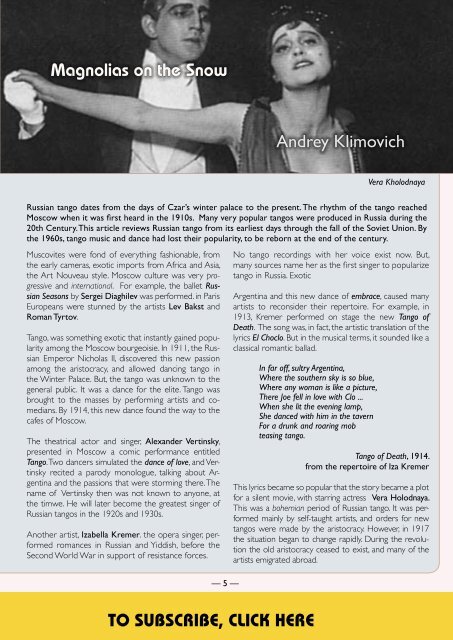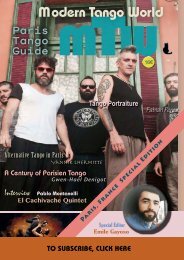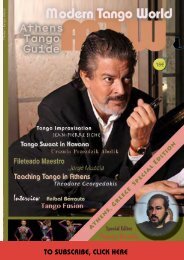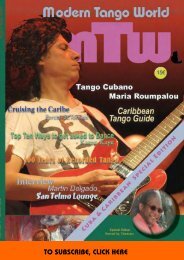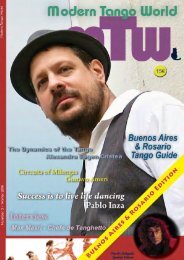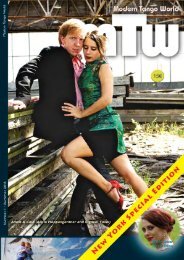Modern Tango World #8 (Moscow)
Moscow Special Features Magnolias on the Snow Andrey Klimovich 03 Milonga Chique Evgeny Morozow 10 The New Moscow Polina Yegurnova 14 Guide to Tango in Moscow 18 Sunset Tango Collages Denise Mumm 22 Interview with Jonathan Goldman Marco Buso 26 The Other Night at La Viruta Daniel Pereyra 31 Book Review: Tango Awareness Alexandru Eugen Cristea 34 Why There is so Little Dance in Dancing Tango Veronica Toumanova 35 New Tango Music Arndt Büssing 38 Tango Moves: Boleos (Voleos) Raymond Lauzzana 42 Letters to the Editor 46
Moscow Special Features
Magnolias on the Snow Andrey Klimovich 03
Milonga Chique Evgeny Morozow 10
The New Moscow Polina Yegurnova 14
Guide to Tango in Moscow 18
Sunset Tango Collages Denise Mumm 22
Interview with Jonathan Goldman Marco Buso 26
The Other Night at La Viruta Daniel Pereyra 31
Book Review: Tango Awareness Alexandru Eugen Cristea 34
Why There is so Little Dance in Dancing Tango Veronica Toumanova 35
New Tango Music Arndt Büssing 38
Tango Moves: Boleos (Voleos) Raymond Lauzzana 42
Letters to the Editor 46
You also want an ePaper? Increase the reach of your titles
YUMPU automatically turns print PDFs into web optimized ePapers that Google loves.
Magnolias on the Snow<br />
Andrey Klimovich<br />
Vera Kholodnaya<br />
Russian tango dates from the days of Czar’s winter palace to the present. The rhythm of the tango reached<br />
<strong>Moscow</strong> when it was first heard in the 1910s. Many very popular tangos were produced in Russia during the<br />
20th Century. This article reviews Russian tango from its earliest days through the fall of the Soviet Union. By<br />
the 1960s, tango music and dance had lost their popularity, to be reborn at the end of the century.<br />
Muscovites were fond of everything fashionable, from<br />
the early cameras, exotic imports from Africa and Asia,<br />
the Art Nouveau style. <strong>Moscow</strong> culture was very progressive<br />
and international. For example, the ballet Russian<br />
Seasons by Sergei Diaghilev was performed. in Paris<br />
Europeans were stunned by the artists Lev Bakst and<br />
Roman Tyrtov.<br />
<strong>Tango</strong>, was something exotic that instantly gained popularity<br />
among the <strong>Moscow</strong> bourgeoisie. In 1911, the Russian<br />
Emperor Nicholas II, discovered this new passion<br />
among the aristocracy, and allowed dancing tango in<br />
the Winter Palace. But, the tango was unknown to the<br />
general public. It was a dance for the elite. <strong>Tango</strong> was<br />
brought to the masses by performing artists and comedians.<br />
By 1914, this new dance found the way to the<br />
cafes of <strong>Moscow</strong>.<br />
The theatrical actor and singer, Alexander Vertinsky,<br />
presented in <strong>Moscow</strong> a comic performance entitled<br />
<strong>Tango</strong>. Two dancers simulated the dance of love, and Vertinsky<br />
recited a parody monologue, talking about Argentina<br />
and the passions that were storming there. The<br />
name of Vertinsky then was not known to anyone, at<br />
the timwe. He will later become the greatest singer of<br />
Russian tangos in the 1920s and 1930s.<br />
Another artist, Izabella Kremer. the opera singer, performed<br />
romances in Russian and Yiddish, before the<br />
Second <strong>World</strong> War in support of resistance forces.<br />
No tango recordings with her voice exist now. But,<br />
many sources name her as the first singer to popularize<br />
tango in Russia. Exotic<br />
Argentina and this new dance of embrace, caused many<br />
artists to reconsider their repertoire. For example, in<br />
1913, Kremer performed on stage the new <strong>Tango</strong> of<br />
Death. The song was, in fact, the artistic translation of the<br />
lyrics El Choclo. But in the musical terms, it sounded like a<br />
classical romantic ballad.<br />
In far off, sultry Argentina,<br />
Where the southern sky is so blue,<br />
Where any woman is like a picture,<br />
There Joe fell in love with Clo ...<br />
When she lit the evening lamp,<br />
She danced with him in the tavern<br />
For a drunk and roaring mob<br />
teasing tango.<br />
<strong>Tango</strong> of Death, 1914.<br />
from the repertoire of Iza Kremer<br />
This lyrics became so popular that the story became a plot<br />
for a silent movie, with starring actress Vera Holodnaya.<br />
This was a bohemian period of Russian tango. It was performed<br />
mainly by self-taught artists, and orders for new<br />
tangos were made by the aristocracy. However, in 1917<br />
the situation began to change rapidly. During the revolution<br />
the old aristocracy ceased to exist, and many of the<br />
artists emigrated abroad.<br />
— 5 —<br />
TO SUBSCRIBE, CLICK HERE


